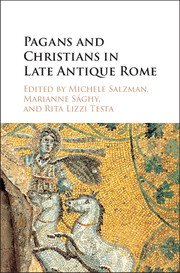 Pagans and Christians in Late Antique Rome
Pagans and Christians in Late Antique Rome Book contents
- Frontmatter
- Contents
- List of Illustrations
- Biographies of Authors
- Acknowledgments
- Introduction
- Part I SENATORIAL POLITICS AND RELIGIOUS CONFLICT
- Part II The Construction of New Religious Identities
- 4 Christians and the Invention of Paganism in the Late Roman Empire
- 5 Late Antique Divi and Imperial Priests of the Late Fourth and Early Fifth Centuries
- 6 Artis heu magicis : The Label of Magic in Fourth-Century Conflicts and Disputes
- 7 Crowd Behavior in Late Antique Rome
- Part III Pagans and Christians: Coexistence and Competition
- Section A Pagans and Religious Practices in Christian Rome
- Section B Death and the Afterlife
- Section C Reading Religious Iconography as Evidence for Pagan–Christian Relations
- Concluding Remarks: Vrbs Roma between Pagans and Christians
- Index
- References
4 - Christians and the Invention of Paganism in the Late Roman Empire
from Part II - The Construction of New Religious Identities
Published online by Cambridge University Press: 05 November 2015
- Frontmatter
- Contents
- List of Illustrations
- Biographies of Authors
- Acknowledgments
- Introduction
- Part I SENATORIAL POLITICS AND RELIGIOUS CONFLICT
- Part II The Construction of New Religious Identities
- 4 Christians and the Invention of Paganism in the Late Roman Empire
- 5 Late Antique Divi and Imperial Priests of the Late Fourth and Early Fifth Centuries
- 6 Artis heu magicis : The Label of Magic in Fourth-Century Conflicts and Disputes
- 7 Crowd Behavior in Late Antique Rome
- Part III Pagans and Christians: Coexistence and Competition
- Section A Pagans and Religious Practices in Christian Rome
- Section B Death and the Afterlife
- Section C Reading Religious Iconography as Evidence for Pagan–Christian Relations
- Concluding Remarks: Vrbs Roma between Pagans and Christians
- Index
- References
Summary
Introduction
Generally, accounts of the relations between Christians and pagans in the late ancient Roman Empire start from an implicit assumption. According to this assumption the Christians and pagans formed two distinct groups, which, although interacting with each other in various ways, existed – so to speak – as two separate and mutually independent “entities.”
These “entities,” so it appears, had their own characteristic features, rituals, and beliefs, or – to put it more generally – their respective ways of interpreting and dealing with the world. All of these elements formed what we nowadays might call the group identities of Christians and pagans. And it is, among other things, these identities, which suggest that in talking about Christians and pagans we are dealing with two distinct groups that as such existed in the “real world.” Starting from this hypothesis, investigations of the two groups and their relations usually take account of issues such as whether these relations were rather hostile or friendly, or how the Christians related to the pagan Roman Empire, and so on.
Certainly, such an approach is apparently quite reasonable and useful with regard to many contexts and investigations pertaining to the relations between Christians and pagans. And yet, considered from a particular point of view, this way of looking at the subject proves rather questionable. To show why this is the case, I will develop an argument along the following lines: There is an important sense in which Christians and pagans did depend on each other and in which they cannot be considered as two discrete and separate groups. As shall become evident, this dependence, or rather “interdependence,” lies on a conceptual level. That is to say that the concepts of what it meant to be pagan and of what it meant to be Christian in the late ancient Roman Empire can only be understood in relation to each other. To expound more clearly what this conceptual interdependence consists in and which consequences arise from this idea, I will make a second point closely related to the first one. It concerns the much-discussed question of why, in the fourth century, Christian authors in the western part of the empire actually started using the term “pagan,” applying it in the sense of “non-Christian.”
- Type
- Chapter
- Information
- Pagans and Christians in Late Antique RomeConflict, Competition, and Coexistence in the Fourth Century, pp. 115 - 138Publisher: Cambridge University PressPrint publication year: 2015
References
- 1
- Cited by


